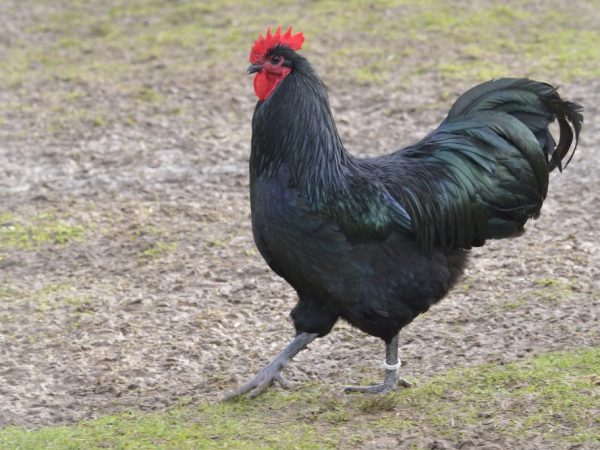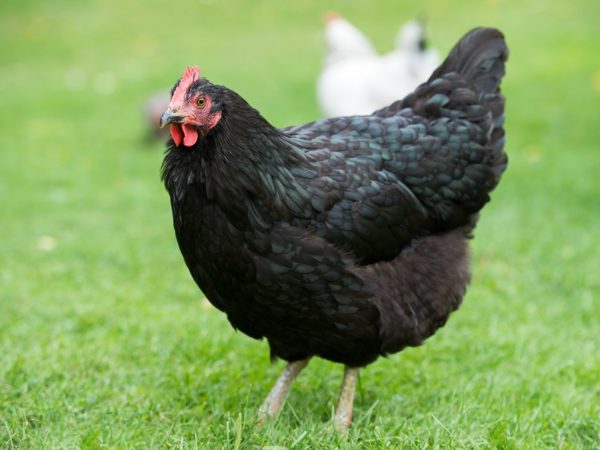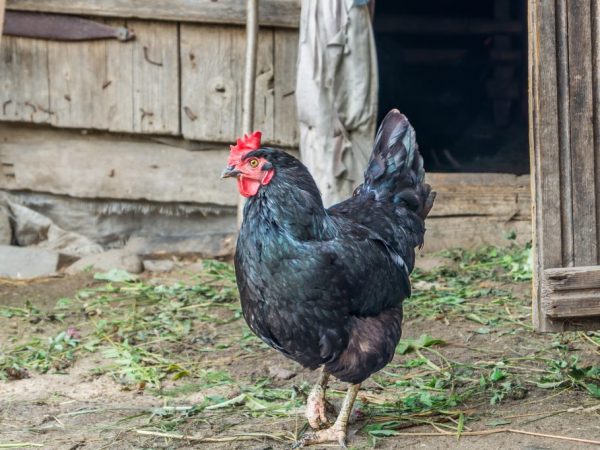Breed of chickens Moscow black
One of the best achievements of modern breeding is the Moscow black breed of chickens, for which three varieties were taken - Yurlovskie vociferous, New Hampshire and brown Leghorns. Newly bred birds were re-crossed with each other, as a result, we got a good livestock of meat and egg direction.

Breed of chickens Moscow black
Features of the breed
The appearance of this bird has several qualities and features:
- the body is elongated, the shape is correct, the muscles are well developed;
- the chest is convex, the head is wide;
- average neck length;
- scallop is compact, erect;
- orange eyes;
- beak is black, slightly curved;
- wings and tail of moderate length;
- earlobes are white or red;
- due to dark pigmentation, the legs of chickens are dark black or black, in roosters they are lighter;
- resin feathers with a golden tint.
Individuals of the male sex are easy to identify in the herd due to the massive and large frame, as well as the bright color - the shoulders, loin and mane of a golden tone.
In females, the plumage is more modest - the whole body is covered with black plumage and only the neck area has a copper-gold tint. Almost 100% of the brood chicks hatch black.
Due to its dense feather cover, this breed can withstand harsh winters.
The cost
One of the main advantages of the breed is its low cost. Hatching eggs are sold at 50-60 rubles per 1 piece, young animals - 600-800 rubles per head.
You can buy chickens in several farms in our country - Orlovsky Dvorik, Kurchinsky, Ecofazenda.
Character
Moscow black chickens have a calm and unassuming character. They easily tolerate moving to new living conditions without reducing productivity.
They are released on a walking yard without a fence and fear that they will go far or fly away.
Male individuals are not aggressive, they treat their owners favorably, but in the presence of a threat they can become good defenders for chickens.
Productivity
The Moscow black breed of chickens has relatively good productivity.
- Subject to all the rules of care and maintenance, chickens reach a mass of 2.5 to 3.5 kg, roosters - 3.5-4.5 kg. After slaughter, the carcass weight is reduced by 600-700 g. The meat is considered a delicacy - tender, juicy and with a low percentage of fat.
- Egg production is good - up to 220 eggs per year. Average weight - 55-60 g. The shell is brown. With insufficient feeding, these indicators can decrease, up to the complete cessation of oviposition. After adjusting the diet and the amount of feed, productivity returns to normal.
- The fertility of the laid eggs is about 90%, of which 92% of the chickens hatch, the survival rate is 95%. Thanks to these parameters, we can say that the breed is beneficial.
Advantages and disadvantages

The breed is easy to care for
After reading the description, you need to decide on the main advantages of Moscow chickens:
- endurance and good immunity against many diseases;
- calm disposition;
- high degree of stress resistance;
- excellent taste of meat and eggs, as well as good meat and egg productivity;
- undemanding to the quality of feed and living conditions.
There are several disadvantages:
- poor hatching instinct, so breeders often have to use an incubator for breeding;
- late egg-laying - six months after birth;
- laying hens' productivity indicators will not last long - about 3 years;
- the bird is prone to obesity in conditions of overfeeding.
Secrets of Successful Breeding
The selectively bred breed lacks incubation instinct. Therefore, breeders breed chickens using the incubation method.
Incubation
For successful breeding, fresh eggs not older than 6 days are used.
Select specimens of medium size with an even, smooth shell, without cracks. The shape is not false to be too pointed or flattened, otherwise the chicks may be born with different defects.
For the selection of material, eight-month-old layers are needed. Their eggs are of good quality and are suitable for a healthy brood.
The incubation period lasts 3-4 weeks. At this time, a stable temperature is provided - 40 ° С in the first week, then every 6 days it is lowered by 1 ° С.
Until hatching occurs, the eggs are regularly turned several times a day. So they warm up evenly, and the chicks hatch strong and healthy.
Feeding and caring for chicks
Of the total number, almost all offspring with black plumage are born. On the first day, chickens of the Moscow breed behave actively - they move quickly and easily adapt to new conditions of detention.
For 45 days, they are provided with good lighting - at least 22 hours and an increased temperature regime within 23-25 ° С.
Starting from the first day, the chicks are given a boiled and chopped chicken egg. After 48 hours, finely chopped green onions are added to the diet, which compensates for the lack of all vitamins and minerals.
After 5 days, they can be given cereals, cottage cheese. As a drink, a glucose solution is served - 50 g per 1 liter of water. Such a drink gives energy, strength and increases the immunity of chickens in the first days of life. After three days, they are sealed with plain water.
From two weeks of age, chicks can be taken outside. Walking in the fresh air on sunny days has a beneficial effect on the growth and development of young animals.
They are transferred to a general flock after 3 months from the moment of birth.
Maintenance of adults
Thanks to their calm disposition, the maintenance of these chickens is uncomplicated. The yard for walking is suitable without a fence, because the birds never leave the yard, they only move a short distance.
The walking area is sown with cereals to provide the herd with greens in the summer. Additionally, the courtyard is sprinkled with shell rock, pieces of chalk, which make up for the lack of calcium after wintering.
For a winter walk in the corner of the yard, you can make a shelter from slate or any other covering material. So the bird will be able to walk in the off-season, looking for the remains of food through the thickness of the snow. Walking in winter is especially useful for laying hens in the henhouse.
Chicken coop requirements

There must be enough space for the bird in the chicken coop.
The room for keeping females and males should be spacious - at the rate of 50 m³ per individual. If there is more space, the birds will freeze in the autumn-winter period.
With crowding, there is a high risk of developing diseases, the appearance of blood-sucking parasites - chewing lice, lice, etc.
Good ventilation is one of the main conditions. During ventilation, there should be no drafts that can cause colds. If you do this regularly, the humidity will remain stably low - at the level of 50-55%. The temperature is also important - in winter about 20-23 ° С, in summer - 12-13 ° С.
The floor surface is sewn up with tin, closing all the cracks so that rodents do not enter. In order to avoid the appearance of fungal infections, the bottom of the chicken coop is treated with slaked lime, then a flooring of straw, sawdust or dry peat is laid. This bedding needs to be changed 1-2 times per year.
Additionally, the walls are whitewashed to destroy pathogenic bacteria and microbes.
In winter, the bird needs good lighting with a red or blue lamp. Dimmed light reduces aggression and has a beneficial effect on egg production. The duration of a light day in winter is at least 20 hours.
Feeders and drinkers are installed in the room.
Diet
Chickens of meat and egg direction need more dry food (by 20%) than egg breeds.
Despite the finicky diet, many breeders report good performance with balanced and regular feeding.
The basis of the diet is made up of two products - hay flour and compound feed. You can diversify such feeding with other components - herbs, fruits, vegetables, wet mash. In summer, hay flour is completely replaced with fresh grass.
To replenish vital elements - calcium, vitamin D, in the winter season they give shells, pieces of chalk, meat and bone and fish meal. Fish oil is added to dry food.
You can give boiled potatoes, but within reasonable limits. These birds are less active than representatives of other breeds, therefore they digest food longer. Potatoes can provoke obesity of internal organs - liver, stomach.
Chickens should have constant access to water - for convenience, many use automated drinkers, in which the liquid stays clean and fresh longer (nipple, groove). In ordinary containers, the drink is changed daily.
Possible diseases
The characteristics of the breed include high resistance to many diseases. If the conditions of care are violated - keeping in a dirty, cold chicken coop, the birds develop colds. To avoid this, it is necessary to optimize the care according to the requirements described above.
In a young brood, various pathologies are noted - curvature of the crest, paws, and neck. The reasons are the use of expired, irregularly shaped and sized eggs for breeding offspring, as well as non-observance of the temperature regime in the incubator.
To prevent other infections, breeders vaccinate chicks at an early age, which helps to increase the chances of survival.
In case of illness, vaccinated chickens easily tolerate them and quickly recover. Also, for preventive purposes, it is necessary to maintain cleanliness in the chicken coop, ventilate it regularly, remove feed residues in time and change the water in the drinkers.
Gardeners reviews
Breeders of the Moscow breed leave only positive reviews about it.
- General-purpose chickens, as they are also commonly called among breeders, are universal - they give tasty meat and are distinguished by good egg production.
- For many, especially novice poultry farmers, this is a great option - chickens are not demanding in care, nutrition, while their productivity remains at the highest level.
- Many are satisfied that the bird is calm, does not require a special enclosure for walking, which greatly facilitates caring for it.
- Others prefer this breed due to the good, almost 100%, fertility and survival rate of chicks.


